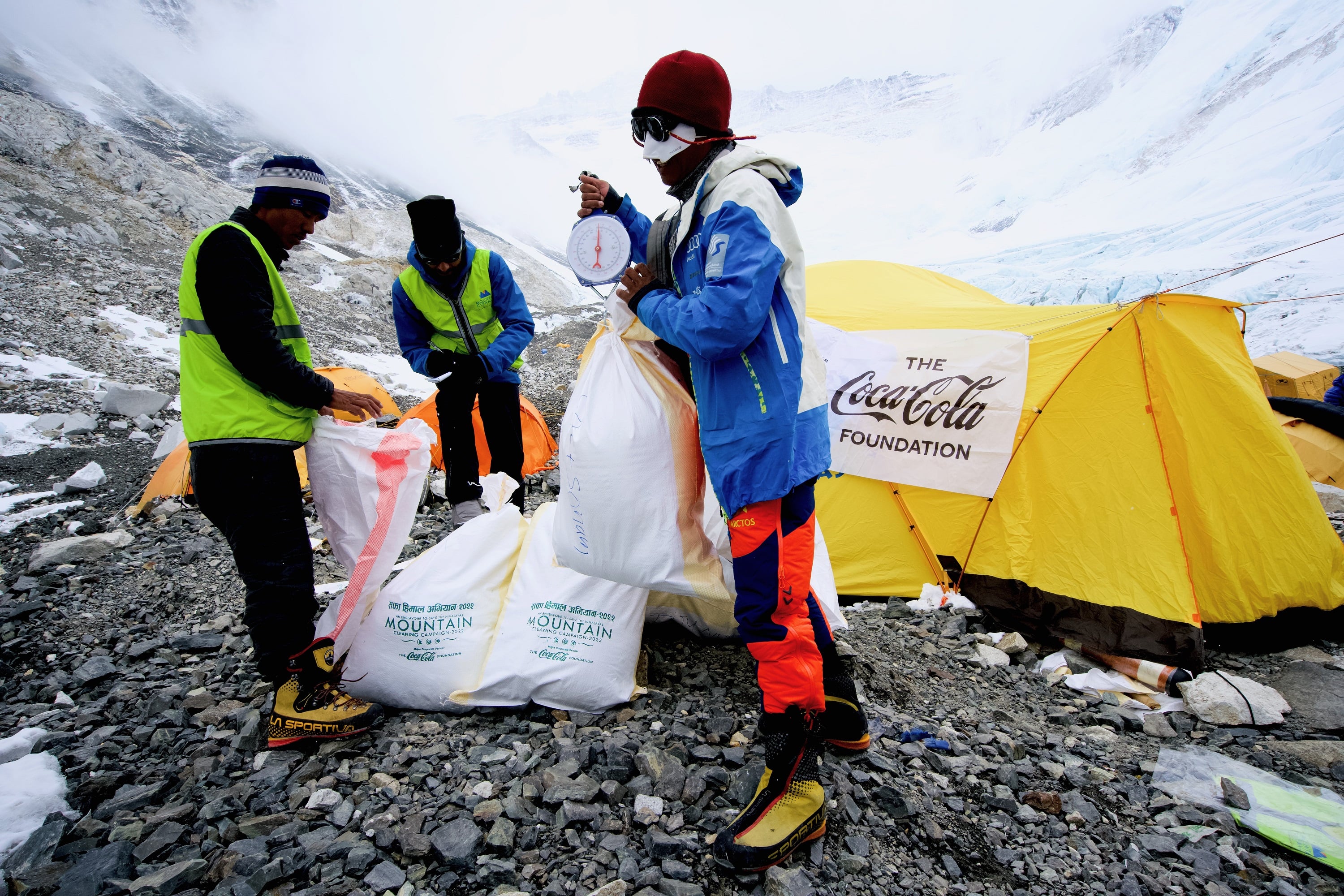Environment

Nepali Army’s continuous involvement in Everest clean-up operation has shone a spotlight on the litters and garbage piling up on some of the planet earth’s highest mountains, including Everest, Kanchenjunga, Dhaulagiri and the Annapurnas, which remain crowded with climbers particularly during Spring and Autumn.
After the two-month-long operation involving 30 army personnel and 48 Sherpa climbers who reached higher than 8,000 meter altitudes, the army said, nearly 34 tons of garbage were collected from Everest, Lhotse, Kanchenjunga and Manaslu. The biggest garbage load was collected from Kanchenjuga (15 tons), followed by Everest and Lhotse combined (nearly 13 tons).

Table: Amount of garbage collected from four peaks cleaned this year. Data: Nepali Army
The army was first roped in to clean up Everest in 2019, but the volume of unattended garbage at higher altitudes meant it needed to continue the campaign every year. Despite efforts to clean up Everest and other Himalayan peaks, Sherpa guides say, unattended garbage such as used mountaineering gears, oxygen cylinders, human waste and bodies of climbers who died scaling or descending the mountains remain an issue.
Renowned guide Kami Rita Sherpa, 52, who set a new world record scaling Everest for a record 26th time this May, welcomed the clean-up initiative, but said much more needs to be done to make Everest and other peaks garbage free: “Bringing back garbage from Camp 2 and Camp 3 is not enough. We have to clean up Camp 4 and other areas above 8,000m, and retrieve dead bodies from the higher elevations.”
Historic mess

Every year, climbers set new records scaling the highest mountain, but they leave behind large piles of garbage, although they are legally required to bring back all the garbage they generate. Along the trails leading to the top of Everest alone, officials say, an estimated 30 tons of garbage and waste are generated every year.
Since 1991, the Sagarmatha Pollution Control Committee (SPCC), a community-led non-governmental organization, has been actively involved in cleaning up Everest and other peaks in Khumbu region. But even after SPCC started work, the dirt scattered on and around Everest continued to make global headlines, after which several clean-up expeditions attempted to make Everest and other peaks garbage free. Yet the problem remained and more clean-up expeditions followed in recent decades.
To clean up the mess, the Nepali Army this year partnered with different government agencies, non-governmental organisations and even private sector. The campaign however was not inexpensive; it required the army to pool together a sum of Rs 120 million, out of which Rs 80 million was provided by the government, while Rs 35 million was collected from public and private sector partners.
Most of the garbage that remain at higher altitudes or are covered under the snow make the clean-up operation even more challenging and risky. Veteran mountaineer Kami Rita told NepalMinute: “The high altitude garbage that we see nowadays is not new, much of it dates back to pre-1953 period, which means even before Tenzing Sherpa and Sir Edmund Hillary first scaled the summit in 1953.”
In an interview with AP1 Television, Brigadier General Himanshu Khadka who led the army’s clean-up campaign, said the garbage collected in the mountains was random, and that the exact date when the garbage was thrown could not be immediately known. Stating that some of the garbage collected dated back many decades, he said, “In fact, we can study the evolution of the equipment by evaluating the garbage alone.”
Types of garbage

Of the nearly 34 tons of garbage collected this year, 26.6 tons were non-biodegradable, while 7.2 tons were biodegradable. The waste produced by the mountaineers ranges from empty oxygen cylinders to empty food cans, and food wrappers and bottles to aluminium ladders and even cooking gas cylinders, and more. Also found are tents and smaller mountaineering gears.
And not to forget human wastes, not all of which are carried down safely as required by government rules. According to an estimate, about 10,000 kilograms of human waste was generated by climbers and their supporting staff at different camps of Everest. This does not include the waste generated on the Chinese side of the mountain. Much of the human waste was transported to a biogas plant based in lower Khumbu.
Dead bodies on the mountains
According to The Himalayan Database, 451 people died while climbing Eight Thousanders in Nepal, between 1990 to 2019, and numerous bodies of those fallen adventurers still remain there. It is estimated that Everest alone is a resting place to over 200 mountaineers, who breathed their last while scaling or descending the mountain.
Although no bodies were removed from Everest, the army-led clean-up team gathered skeletons of two dead bodies from Kanchenjunga Base Camp. Along higher altitudes of popular peaks like Everest and Annapurna, there are so many bodies that Purnima Shrestha, one of few Nepali women to scale all seven Eight Thousanders in Nepal, feels anxious and discouraged at the sight of one.
“My guides suggest me to not look at the bodies while scaling the mountains,” she said.
According to Phurba Tenjing Sherpa, before 2013 there were a lot of dead bodies visibly present en route to Everest, with Camp 4 area appearing like a frozen graveyard with at least 4 dead bodies there. Near the Triangular Face and Balcony areas of Everest, there are at least six bodies, and a few more near the Hillary Step, the last obstacle before the summit of Everest, he said.
Government rules
In 2014 the government of Nepal introduced new rules requiring every mountaineer bring back at least eight kilograms of garbage from the mountain. For Everest, the SPCC has been trying to ensure that that the rule is followed, and garbage duly submitted. Each expedition team has to make a refundable deposit of 4000 US dollars for Everest, and $3000 for other 8000+ meter mountains.
Tshering Sherpa, the SPCC CEO, said that the rule to bring back eight kilograms of garbage “might not always be compulsory”. He said that the SPCC monitors the weather and accordingly sets a limit as to how much garbage individual mountaineers are required to bring back down.
Phurba Tenjing Sherpa has scaled Everest several times, and each time he worshiped the peak as a home of goddess Chomolungma. But he said he was upset to see garbage in the holy mountain: “Everest is our mother of god so we try to keep it clean as much as possible, we do not leave trash there except in life threatening situations.”
What next?

Veteran mountain guide Kami Rita suggested that “such clean-up campaigns should hire more and more Sherpas to collect high altitude garbage and reward those who collect more garbage”. Stating that Sherpa mobilisation would be more effective that army mobilisation, he said, “There’s a difference between one Sherpa team cleaning up the mountain than 20 or more Sherpa teams doing the job.”
Another mountain guide, Phurba Tenjing Sherpa, suggests: “The money (that) has been collected for the mountain so (it) should be used for mountain and mountaineering.” Department of Tourism says the government collected nearly 500 million in mountaineering revenues from 986 climbers who were given permits to climb different Himalayan peaks in the Spring of 2022.
Babu Sherpa, who was associated with the army-led ‘Mountain Clean-Up Campaign 2022’, welcomed recent initiatives to clean up mountains, but added that it “it would take at least four to five years of regular cleaning to rid Everest of all the garbage.” Other Sherpas estimate that might take even longer.
SPCC shows the way
Prior to establishment of the SPCC, Tshering Sherpa says, the expedition teams were responsible for gathering and transporting the waste material to Kathmandu. But that was not strictly followed, he added, as some shenanigans attempted to “hoodwink the authorities by submitting garbage produced within the valley as a substitute”.
Kami Rita added, “Before SPCC, there was no cleanliness policy – neither was there any attempt to control littering and pollution. People would litter at the base camp, and just urinate or excrete wherever they liked.” Now with hundreds of climbers, aided by hundreds of supporting staff, crowding the mountain every Spring and Autumn, Sherpa guides say, the risk of littering and pollution remains - not just on Everest but on other popular peaks too.






